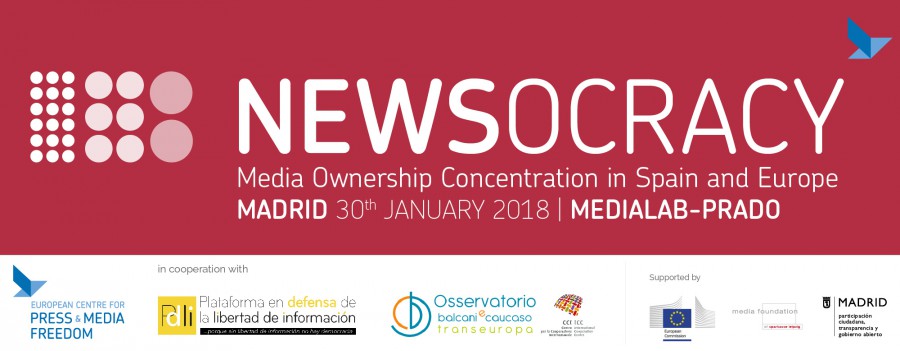
Experts, politicians, journalists, editors and media freedom organisations from all over Europe met on Tuesday, 30 January, 2018 in Madrid, to discuss media ownership concentration and media pluralism. The conference was organised by the European Center for Press and Media Freedom (ECPMF), the Plataforma en Defensa de la Libertad de Información (PDLI) and the Osservatorio Balcani e Caucaso Transeuropa (OBCT) with the support of the European Commission.
At the #NEWSOCRACY conference latest data on media ownership in Europe was analysed (Media Pluralism Monitor), and the still unpublished recommendations of an expert group working for the Council of Europe was presented, on how to improve transparency and competition
In Europe, media ownership concentration is working against a pluralistic and transparent media market. According to the latest data by the Media Pluralism Monitor, in two-thirds of the European countries less than four owners hold 80 per cent of the media.
The highest concentration can be found in the audiovisual sector where in 15 states – out of the 17 that publish their data – 80 per cent of the television market is in the hands of four or less operators. By comparison, in the print sector it is 57 per cent.
Regarding the risk indicators used in the Monitor’s report on the 30 states, the average risk for transparency in media ownership is at 33 per cent (with higher numbers in Greece with 75 per cent, the Czech Republic with 75 per cent and Luxembourg with 69 per cent). The average risk of ownership concentration ranges at 67% (with higher percentages in Ireland with 97% and Sweden, Finland and Bulgaria with 96%).
Lutz Kinkel, Managing Director of the ECPMF points out the lack of transparency in media ownership: "To have valid data on media ownership is like taking a necessary x-ray of the market. Citizens need to know in order to assess the media outlets’ output. Politicians need to know in order to prevent ownership concentration and to be able to guarantee pluralism. Whenever media ownership is disguised there is a reason for that. A bad reason”.
PDLI’s President, Virginia Pérez Alonso, calls media ownership concentration “a scourge of media freedom: The citizens’ right to information requires a pluralism of information on the one hand, and economical and political independence on the other. Unfortunately, these two requirements are not guaranteed in Europe at this time: European citizens do not have access to the information who the owners of the media are and what their news agenda is. Nor do they always have the opportunity to choose of a variety of media, particularly in the audiovisual field," he says.
This concern is shared by Chiara Sighele of OBCT: “‘Who is behind our media?’ is still a too rare question, which too often leads to neither clear nor easy-to-find answers. However investigating media ownership and its financing is gaining momentum in various European countries, a momentum which might be a unique opportunity to push for advancing the requirements and practices of public disclosure and the awareness of an issue with such impact on our democracies".
At the #NEWSOCRACY conference different initiatives from different countries of how to improve media market transparency was introduced. Also, how new technologies may contribute to this. In addition, alternatives to the current situation was looked into, such as new business models, media financing, and new journalistic formats.
Finally, #NEWSOCRACY will presented proposals for state and community regulators, among them, an outlook on the recommendations of the committee of European experts working for the Council of Europe on the subject media ownership concentration.










